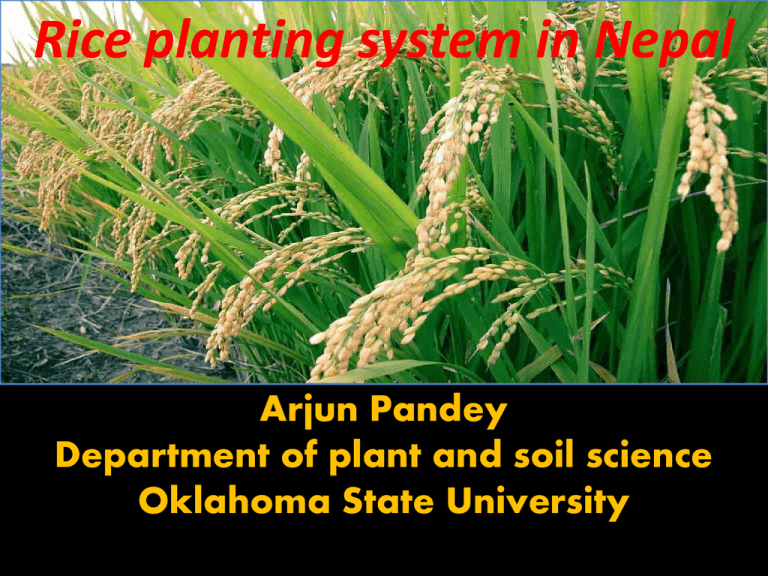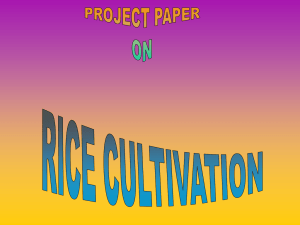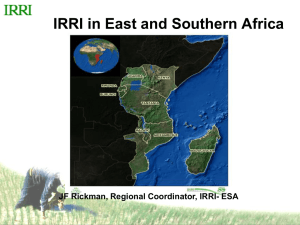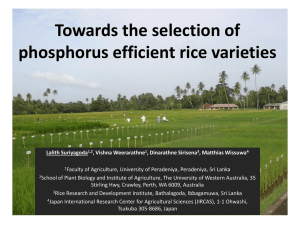Rice planting system in Nepal - Precision Agriculture, SOIL4213
advertisement

Rice planting system in Nepal Arjun Pandey Department of plant and soil science Oklahoma State University Outline • • • • Introduction Agriculture in Nepal Rice Planting System SRI and Conventional Method • Problems • Conclusion Introduction: Background: Area of Nepal-147181sq. Km. Total farming Population-65% 23% of total area is the most fertile land where cereal production is mainly concentrated. Agriculture Contributes to about 33.8% to national GDP.(World Bank,2010) Provides part and fulltime employment opportunities to 65.5% of its population. Elevation ranges from 70 m (230 ft) to 8848 m (29,029 ft) above sea level. Tremendous variation in climate (tropical to temperate) as a result of variation in altitude. There are four main climatic seasons: Spring : March-May Summer : June-August Autumn : September-November Winter : December-February Physiographic Regions and Cropping System • • • • • Himalayan High mountain Middle mountain Siwalik Terai Agriculture in Nepal Among agriculture crops rice is main crop, cultivated on nearly 1.55 M Ha of lands. Total production of rice 2008/09 was 4.3 millions of tons, with average productivity of 2907kg/ha(world average is about 4204kg/ha) Problems of rice cultivation • Older generation of seeds • High Production cost • Low doses of fertilizers • Manual/bullock- Based cultivation • Fraction of land(small holding=0.24ha) • Distribution of land • Low Irrigation facility • Poor Farmers(% of population below international poverty line of US$1.25 per day, 1994-2008*=55) (Unicef,2010) Rice cultivation system: Upland rice cultivation:- 9% of total rice cultivation area is under upland. Lowland rice cultivation: Major practice Cultivated 2 times in a year Different methods of rice planting • Direct planting- In Nepal it is not practiced yet, and research is going on. • Transplanting Two ways of transplanting is popular in Nepal. Conventional Transplanting Modern Transplanting(SRI) Conventional Rice Transplanting System • Farmers Use more than 60 kg of seeds/ha • Transplant very old seedlings(30-45 days) • Plants many seedlings 8-10/hill. Modern Rice Planting System(SRI) • System of Rice Intensification-Evolved in Madagascar, over 20-yr period • In Nepal introduced in 1998 • One seedling per hill. Why SRI ?? Area Production and Yield inNepal 10 5 yield production area 8 4 Area/Yield/Production 6 4 2 0 3 2 1 0 2009 2007 2005 2003 2000 Year SRI Yield (T/Ha) Conventional Yields (T/Ha) 1995 1990 1985 PRACTICE/PURCHASE SEED COST CONVENTIONAL RICE(RS/HA) COSTS,SRI RICE(RS/HA) DIFFERENCE(RS/H A) 125 1250 1125 50 500 450 LAND PREPARATION 7500 7500 0 COMPOST 4800 2400 -2400 FERTILIZERS 1500 3000 1500 TRANSPLANTING 1250 1500 250 IRRIGATION 200 400 200 WEEDING 750 1350 600 PESTICIDE 0 500 500 HARVESTING 1750 1500 -250 TOTAL COST 17925 19900 1975 REVENUE,GRAIN 60450 23250 -37200 3000 3000 0 TOTAL REVENUE 63450 26250 -37200 NETPROFIT 45525 6350 -39175 NURSERY PREPARATION REVENUE,BY PRODUCT Five Principles of SRI Comparisons of factor effects: • Young seedling 8 days-6.28 t/ha vs. 20 days-3.80 t/ha • Water management effect Water control -5.75 t/ha vs. Flooding- 4.34 t/ha • Fertilization Compost-5.49 t/ha vs. NPK fertilizer -4.48 t/ha • Plants per hill effect 1 plant/hill- 5.43 t/ha vs. 3 plants/hill- 4.65 t/ha • Spacing effect 30x30cm- 5.08 t/ha vs. 25x25 cm 5.00 t/ha source-Uphoff, 2006 Twelve Techniques of SRI Nursery Preparation Marking the area Uprooting Seedlings Planting on the spot Intercultural operation Technology Promotion Leaf Color Chart Urea Super Granule Seed Production and Preservation Alternate Wet and Dry(AWD) irrigation System Pheromone trap http://wn.com/samardeen17 Conclusion SRI method is found to be more productive than conventional method Main components for higher yield of rice is younger seedlings, fewer seedlings /hill, wider spacing and AWD irrigation Tools and machines supply/availability for making and weeding are every useful for adopting SRI in larger areas











